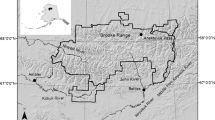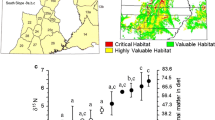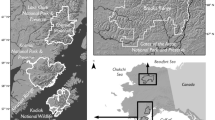Abstract
Behavioral differences within a population can allow use of a greater range of resources among individuals. The brown bear (Ursus arctos) is a generalist omnivore that occupies diverse habitats and displays considerable plasticity in food use. We evaluated whether brown bear foraging that resulted in deviations from a proposed optimal diet influenced body condition and, in turn, denning duration in Lake Clark National Park and Preserve, Alaska. To assess assimilated diet, we used sectioned guard hair samples (n = 23) collected in autumn to determine stable carbon and nitrogen isotope ratios. To index proportional contributions of meat and vegetation to assimilated diets, we compared the carbon (δ13C) and nitrogen (δ15N) values of hair samples with the values identified for major food categories. We then compared percentage body fat and body mass in relation to the proportion of assimilated meat in the diet using linear models. We also examined the influence of autumn percentage body fat and mass on denning duration. Percentage body fat was not influenced by the proportion of assimilated meat in the diet. Additionally, percentage body fat and body mass did not influence denning duration. However, body mass of bears assimilating proportionately more meat was greater than bears assimilating less meat. Our results provide support for previous findings that larger bears consume higher amounts of protein to maintain their body size and therefore forage further from the proposed optimal diet. Additionally, our results demonstrate that individuals can achieve similar biological outcomes (e.g., percentage body fat) despite variable foraging strategies, suggesting that individuals within generalist populations may confer an adaptive advantage through behavioral plasticity.




Similar content being viewed by others
References
Atkinson SN, Ramsay MA (1995) The effects of prolonged fasting of the body composition and reproductive success of female polar bears (Ursus maritimus). Funct Ecol 9:559–567. https://doi.org/10.2307/2390145
Ayers CR, Belant JL, Millspaugh JJ (2013) Directness of resource use metrics affects predictions of bear body fat gain. Polar Biol 36:169–176. https://doi.org/10.1007/s00300-012-1247-7
Belant JL, Kielland K, Follmann EH, Adams LG (2006) Interspecific resource partitioning in sympatric ursids. Ecol Appl 16:2333–2343. https://doi.org/10.1890/1051-0761(2006)016[2333:IRPISU]2.0.CO;2
Belant JL, Griffith B, Zhang Y, Follmann EH, Adams LG (2010) Population–level resource selection by sympatric brown and American black bears in Alaska. Polar Biol 33:31–40. https://doi.org/10.1007/s00300-009-0682-6
Ben-David M, Titus K, Beier LR (2004) Consumption of salmon by Alaskan brown bears: a trade–off between nutritional requirements and the risk of infanticide? Oecologia 138:465–474. https://doi.org/10.1007/s00442-003-1442-x
Bennett AJ, Thompson WL, Mortenson DC (2006) Vital signs monitoring plan, Southwest Alaska Network. National Park Service. https://science.nature.nps.gov/im/monitor/plans/SWAN_MonitoringPlan.pdf
Bolnick DI, Svanbäck R, Araújo MS, Persson L (2007) Comparative support for the niche variation hypothesis that more generalized populations also are more heterogeneous. Proc Natl Acad Sci 104: 10075–10079. https://doi.org/10.1073/pnas.0703743104
Brazil CE, Bue D, Elison TB (2013) 2011 Kuskokwim area management report. Alaska Department of Fish and Game, Division of Sport Fish, Research and Technical Services
Bürger R (2005) A multilocus analysis of intraspecific competition and stabilizing selection on a quantitative trait. J Math Biol 50:355–396. https://doi.org/10.1007/s00285-004-0294-2
Cattet MR, Caulkett NA, Obbard ME, Stenhouse GB (2002) A body-condition index for ursids. Can J Zoolog 80:1156–1161. https://doi.org/10.1139/z02-103
Cook SA, Johnson MP (1968) Adaptation to heterogeneous environments. I. Variation in heterophylly in Ranunculus flammula L. Evolution 22:496–516. https://doi.org/10.2307/2406876
Costello CM, Cain SL, Pils S, Frattaroli L, Haroldson MA, van Manen FT (2016) Diet and macronutrient optimization in wild ursids: a comparison of grizzly bears with sympatric and allopatric black bears. PLoS ONE 1:e0153702. https://doi.org/10.1371/journal.pone.0153702
Darimont CT, Paquet PC, Reimchen TE (2009) Landscape heterogeneity and marine subsidy generate extensive intrapopulation niche diversity in a large terrestrial vertebrate. J Anim Ecol 78:126–133. https://doi.org/10.1111/j.1365-2656.2008.01473
Dormann CF, Elith J, Bacher S, Buchmann C, Carl G, Carré G, Marquéz JRG, Gruber B, Lafourcade B, Leitão PJ, Münkemüller T, McClean C, Osborne PE, Reineking B, Schröder B, Skidmore AK, Zurell D, Lautenbach S (2013) Collinearity: a review of methods to deal with it and a simulation study evaluating their performance. Ecography 36:27–46. https://doi.org/10.1111/j.1600-0587.2012.07348
Erlenbach JA, Rode KD, Raubenheimer D, Robbins CT (2014) Macronutrient optimization and energy maximization determine diets of brown bears. J Mamm 95:160–168. https://doi.org/10.1644/13-MAMM-A-161
Farley S (2003) Impacts of heavy hunting pressure on the density and demographics of brown bear populations in southcentral Alaska. Alaska Department of Fish and Game. https://adfg.state.ak.us/static/home/library/pdfs/wildlife/research_pdfs/brb–heavy03f.pdf
Farley SD, Robbins CT (1994) Development of two methods to estimate body composition of bears. Can J Zool 72:220–226. https://doi.org/10.1139/z94-029
Felicetti LA, Robbins CT, Shipley LA (2003) Dietary protein content alters energy expenditure and composition of the mass gain in grizzly bears (Ursus arctos horribilis). Physiol Biochem Zool 76:256–261. https://doi.org/10.1086/374279
Felicetti LA, Schwartz CC, Rye RO, Gunther KA, Crock JG, Haroldson MA, Waits L, Robbins CT (2004) Use of naturally occurring mercury to determine the importance of cutthroat trout to Yellowstone grizzly bears. Can J Zool 82:493–501. https://doi.org/10.1139/z04-013
Gordon DM (1991) Behavioral flexibility and the foraging ecology of seed-eating ants. Am Nat 138:379–411
Grémillet D, Pichegru L, Kuntz G, Woakes AG, Wilkinson S, Crawford RJ, Ryan PG (2008) A junk-food hypothesis for gannets feeding on fishery waste. Proc R Soc Lond 275:1149–1156. https://doi.org/10.1098/rspb.2007.1763
Harlow HJ, Lohuis T, Grogan RG, Beck TDI (2002) Body mass and lipid changes by hibernating reproductive and nonreproductive black bears (Ursus americanus). J Mamm 83:1020–1025
Hiesey WM (1953) Comparative growth between and within climatic races of Achillea under controlled conditions. Evolution 7:297–316. https://doi.org/10.2307/2405341
Hilderbrand GV, Farley SD, Robbins CT, Hanley TA, Titus K, Servheen C (1996) Use of stable isotopes to determine diets of living and extinct bears. Can J Zool 74:2080–2088. https://doi.org/10.1139/z96-236
Hilderbrand GV, Farley SD, Robbins CT (1998) Predicting body condition of bears via two field methods. J Wildl Manage 62:406–409. https://doi.org/10.2307/3802306
Hilderbrand GV, Jenkins SG, Schwartz CC, Hanley TA, Robbins CT (1999a) Effect of seasonal differences in dietary meat intake on changes in body mass and composition in wild and captive brown bears. Can J Zool 77:1623–1630. https://doi.org/10.1139/z99-133
Hilderbrand GV, Schwartz CC, Robbins CT, Jacoby ME, Hanley TA, Arthur SM, Servheen C (1999b) The importance of meat, particularly salmon, to body size, population productivity, and conservation of North American brown bears. Can J Zool 77:132–138. https://doi.org/10.1139/z98-195
Hobson KA, McLellan BN, Woods JG (2000) Using stable carbon (δ13C) and nitrogen (δ15N) isotopes to infer trophic relationships among black and grizzly bears in the upper Columbia River basin, British Columbia. Can J Zool 78:1332–1339. https://doi.org/10.1139/z00-069
Hutchinson GE (1957) Concluding remarks. Cold Spring Harb Symp Quant Biol 22:415–427
Kline TC, Goering JJ, Mathisen OA, Poe PH, Parker PL, Scalan RS (1993) Recycling of elements transported upstream by runs of Pacific salmon: II. δ15N and δ13C evidence in the Kvichak River watershed, Bristol Bay, southwestern Alaska. Can J Fish Aquat Sci 50:2350–2365. https://doi.org/10.1139/f90-014
Klinka DR, Reimchen TE (2002) Nocturnal and diurnal foraging behaviour of brown bears (Ursus arctos) on a salmon stream in coastal British Columbia. Can J Zool 80:1317–1322. https://doi.org/10.1139/z02-123
Lafferty DJ, Belant JL, Phillips DL (2015) Testing the niche variation hypothesis with a measure of body condition. Oikos 124:732–740. https://doi.org/10.1111/oik.01741
Lake Clark National Park (2013) Fact sheet. National Park Service. https://www.nps.gov/lacl/planyourvisit/upload/Fact–Sheet–Final–accessible–2013.pdf
Lipkin R (2002) Lake Clark National Park and Preserve vascular plant inventory, 2001 field season annual progress report. Alaska Natural Heritage Program. http://accs.uaa.alaska.edu/files/botany/Publications/2002/Lake_Clark_National_Park_Vascular_Plant_Inventory.pdf
Manchi S, Swenson JE (2005) Denning behaviour of Scandinavian brown bears Ursus arctos. Wildl Biol 11:123–132. https://doi.org/10.2981/0909-6396(2005)11[123:DBOSBB]2.0.CO;2
Mangipane LS, Belant JL, Mangipane BA, Gustine DD, Hilderbrand GV (in review) Female brown bear den-site selection and chronology supports avoidance of infanticide risk. Mam Biol
Marshall DR, Jain SK (1969) Interference in pure and mixed populations of Avena fatua and A. barbata. J Ecol 57:251–270. https://doi.org/10.2307/2258219
McNab BK (1971) On the ecological significance of Bergmann’s rule. Ecology 52:845–854. https://doi.org/10.2307/1936032
Ménard N (2002) Ecological plasticity of Barbary macaques (Macaca sylvanus). Evol Anthropol 11:95–100. https://doi.org/10.1002/evan.10067
Miller SD, White GC, Sellers RA, Reynolds HV, Schoen JW, Titus K, Barnes VG, Smith RB, Nelson RR, Ballard WB, Schwartz CC (1997) Brown and black bear density estimation in Alaska using radiotelemetry and replicated mark–resight techniques. Wildl Monogr 133:3–55
Nelson RA, Folk GE, Pfeiffer EW, Craighead JJ, Jonkel CJ, Steiger DL (1983) Behavior, biochemistry, and hibernation in black, grizzly, and polar bears. Int C Bear 5:284–290. https://doi.org/10.2307/3872551
Noyce KV, Garshelis DL (1994) Body size and blood characteristics as indicators of condition and reproductive performance in black bears. Int C Bear 9:481–496. https://doi.org/10.2307/3872736
Oelze VM (2016) Reconstructing temporal variation in great ape and other primate diets: a methodological framework for isotope analyses in hair. Am J Primatol 78:1004–1016
Olson T, Putera J (2007) Refining techniques to survey harvested brown bear populations in Katmai National Park and Preserve and Lake Clark National Park and Preserve. National Park Service. http://www.arlis.org/docs/vol1/181067430.pdf
Parnell AC, Inger R, Bearhop S, Jackson AL (2010) Source partitioning using stable isotopes: coping with too much variation. PLoS ONE 5:e9672. https://doi.org/10.1371/journal.pone.0009672
Pasitschniak-Arts M (1993) Mammalian species: Ursus arctos. Am Soc Mamm 439:1–10. https://doi.org/10.2307/3504138
Peterson BJ, Fry B (1987) Stable isotopes in ecosystem studies. Annu Rev Ecol Syst 18:293–320
Peterson G, Allen CR, Holling CS (1998) Ecological resilience, biodiversity, and scale. Ecosystems 1:6–18. https://doi.org/10.1007/s100219900002
Pigeon KE, Stenhouse G, Côté SD (2016) Drivers of hibernation: linking food and weather to denning behaviour of grizzly bears. Behav Ecol Sociobiol 70:1745–1754
Pritchard GT, Robbins CT (1990) Digestive and metabolic efficiencies of grizzly and black bears. Can J Zool 68:1645–1651. https://doi.org/10.1139/z90-244
Ramsay MA, Stirling I (1988) Reproductive biology and ecology of female polar bears (Ursus maritimus). J Zool 214:601–633. https://doi.org/10.1111/j.1469-7998.1988.tb03762.x
Relyea RA (2001) Morphological and behavioral plasticity of larval anurans in response to different predators. Ecology 82:523–540. https://doi.org/10.1890/0012-9658(2001)082[0523:MABPOL]2.0.CO;2
Robbins CT, Fortin JK, Rode KD, Farley SD, Shipley LA, Felicetti LA (2007) Optimizing protein intake as a foraging strategy to maximize mass gain in an omnivore. Oikos 116:1675–1682. https://doi.org/10.1111/j.0030-1299.2007.16140.x
Robbins CT, Ben-David M, Fortin JK, Nelson OL (2012) Maternal condition determines birth date and growth of newborn bear cubs. J Mamm 93:540–546. https://doi.org/10.1644/11-MAMM-A-155.1
Rode KD, Robbins CR, Shipley LA (2001) Constraints on herbivory by grizzly bears. Oecologia 128:62–71. https://doi.org/10.1007/s004420100637
Rogers MC, Peacock E, Simac K, O’Dell MB, Welker JM (2015) Diet of female polar bears in the southern Beaufort Sea of Alaska: evidence for an emerging alternative foraging strategy in response to environmental change. Polar Biol 38:1035–1047. https://doi.org/10.1007/s00300-015-1665-4
Salomone P, Morstad S, Sands T, Jones M, Baker T, Buck G, West F, Krieg T (2011) 2010 Bristol Bay area annual management report. Fishery Management Report No. 11–23. Alaska Department of Fish and Game. http://www.sf.adfg.state.ak.us/FedAidpdfs/FMR11–23.pdf
Schwartz CC, Franzmann AW (1998) Ecology and management of the North American moose. Smithsonian Institution Press, Washington, DC
Schwartz CC, Miller SD, Franzmann AW (1987) Denning ecology of three black bear populations in Alaska. Int C Bear 7:281–291. https://doi.org/10.2307/3872635
Servheen C, Herrero S, Peyton B (1999) Bears status survey and conservation action plan. IUCN, Cambridge
Sikes RS, Gannon WL, the Animal Care and Use Committee of the American Society of Mammalogists (2011) Guidelines of the American Society of Mammalogists for the use of wild mammals in research. J Mamm 92:235–253. https://doi.org/10.1644/10-MAMM-F-355.1
Smith RL, Smith TM (2001) Ecology and field biology. California, San Francisco
Stanek AE (2014) Dietary ecology of Alaskan gray wolves: variation in seasonal foraging strategies in a salmon subsidized ecosystem. Thesis, University of Alaska Anchorage
Taylor W, Reynolds H, Ballard W (1989) Immobilization of grizzly bears with tiletamine hydrochloride and zolazepam hydrochloride. J Wildl Manage 53:978–981. https://doi.org/10.2307/3809598
Van Daele LJ, Barnes VG, Belant JL (2012) Ecological flexibility of brown bears on Kodiak Island, Alaska. Ursus 23:21–29. https://doi.org/10.2192/URSUS-D-10-00022.1
Van Valen L (1965) Morphological variation and width of ecological niche. Am Nat 99:377–390
Vander Zanden HB, Bjorndal KA, Reich KJ, Bolten AB (2010) Individual specialists in a generalist population: results from a long-term stable isotope series. Biol Lett 6:711–714. https://doi.org/10.1098/rsbl.2010.0124
Waller BW, Belant JL, Young BW, Leopold BD, Simek SL (2012) Denning chronology and den characteristics of American black bears in Mississippi. Ursus 23:6–11. https://doi.org/10.2192/URSUS-D-11-00014.1
Welch CA, Keay J, Kendall KC, Robbins CT (1997) Constraints on frugivory by bears. Ecology 8:1105–1119. https://doi.org/10.1890/0012-9658(1997)078[1105:COFBB]2.0.CO;2
Zedrosser A, Bellemain E, Taberlet P, Swenson JE (2007) Genetic estimates of annual reproductive success in male brown bears: the effects of body size, age, internal relatedness and population density. J Anim Ecol 76:368–375. https://doi.org/10.1111/j.1365-2656.2006.01203.x
Acknowledgements
We thank the National Park Service for funding this project (Grant Number P15AC01024). We also thank Mississippi State University and the U.S. Geological Survey for their support. We thank Matthew Rogers for analyzing hair samples, Tewosret Vaughn for formatting assistance, Layne Adams for editorial comments, and Regan Sarwas for Geographic Information System (GIS) assistance. We thank pilots Troy Cambier, Rich Richotte, Don Welty, Andy Greenblatt, Matt Keller, and Lynn Ellis for making capture efforts possible. Any use of trade, product, or firm names is for descriptive purposes only and does not imply endorsement by the US Government.
Funding
This study was funded by the National Park Service (Grant Number P15AC01024).
Author information
Authors and Affiliations
Corresponding author
Rights and permissions
About this article
Cite this article
Mangipane, L.S., Belant, J.L., Lafferty, D.J.R. et al. Dietary plasticity in a nutrient-rich system does not influence brown bear (Ursus arctos) body condition or denning. Polar Biol 41, 763–772 (2018). https://doi.org/10.1007/s00300-017-2237-6
Received:
Revised:
Accepted:
Published:
Issue Date:
DOI: https://doi.org/10.1007/s00300-017-2237-6




